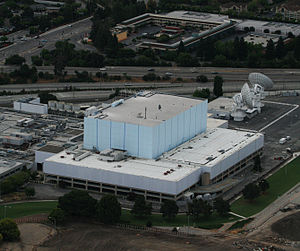Onizuka Air Force Station
| Onizuka Air Force Station | |
|---|---|
| Part of Air Force Space Command (AFSPC) | |
| Moffett Federal Airfield, California | |

Onizuka Air Force Station
|
|
| Coordinates | 37°24′27.35″N 122°1′36.40″W / 37.4075972°N 122.0267778°WCoordinates: 37°24′27.35″N 122°1′36.40″W / 37.4075972°N 122.0267778°W |
| Type | Air Force Station |
| Site information | |
| Controlled by | United States Air Force |
| Condition | Demolished |
| Site history | |
| Built | 1960 |
| In use | 1960 - 2010 |
| Demolished | 2014 |
| Battles/wars | Classified |
| Garrison information | |
| Garrison | 21st Space Operations Squadron |
Onizuka Air Force Station was a United States Air Force installation in Santa Clara County, California, just outside the city limits of Sunnyvale, at the intersection of U.S. Route 101 and State Route 237. It was operational from 1960 to 2010.
Its distinguishing feature was Building 1003, known locally as the Blue Cube or simply the "Cube" given its size, color, and lack of windows. The station's other distinguishing features were its three primary parabolic dish antennas used for communication with remote tracking stations used to control military satellites; these antennas were named Sun East, Sun West, and Sun 3.
In the United States space program's formative stages, Air Force Systems Command contracted with the Philco Ford division of Ford Motor Company to provide interim operational facilities at its Palo Alto, California, location. Operations commenced in the late 1950s. By 1958, the United States Air Force sought a permanent home with larger facilities. Ultimately, the United States Air Force purchased roughly 19 acres of land from Lockheed Corporation, which included Lockheed Building 100, and was named Sunnyvale Air Force Station. Construction of the station's original facilities was completed in 1960. Over time, additional structures were built as operations expanded.
The station was home to the Air Force Systems Command operational unit known as the Air Force Satellite Test Center (STC, colloquially called the "stick)," and other non-Air Force Systems Command operational organizations. By 1979, the Air Force Satellite Test Center was renamed the Air Force Satellite Control Facility. In 1986, the same year of the Challenger explosion, Sunnyvale AFS was renamed Onizuka AFB in honor of Air Force Lt. Colonel Ellison S. Onizuka, an astronaut that died on the Challenger. Ultimately, both Onizuka Air Force Station and the Air Force Satellite Control Facility were transferred from Air Force Systems Command to Air Force Space Command and was operated by the 21st Space Operations Squadron, a geographically separated unit (GSU) of the 50th Space Wing. The non-Air Force System Command operational organizations remained under their respective commands.
...
Wikipedia

